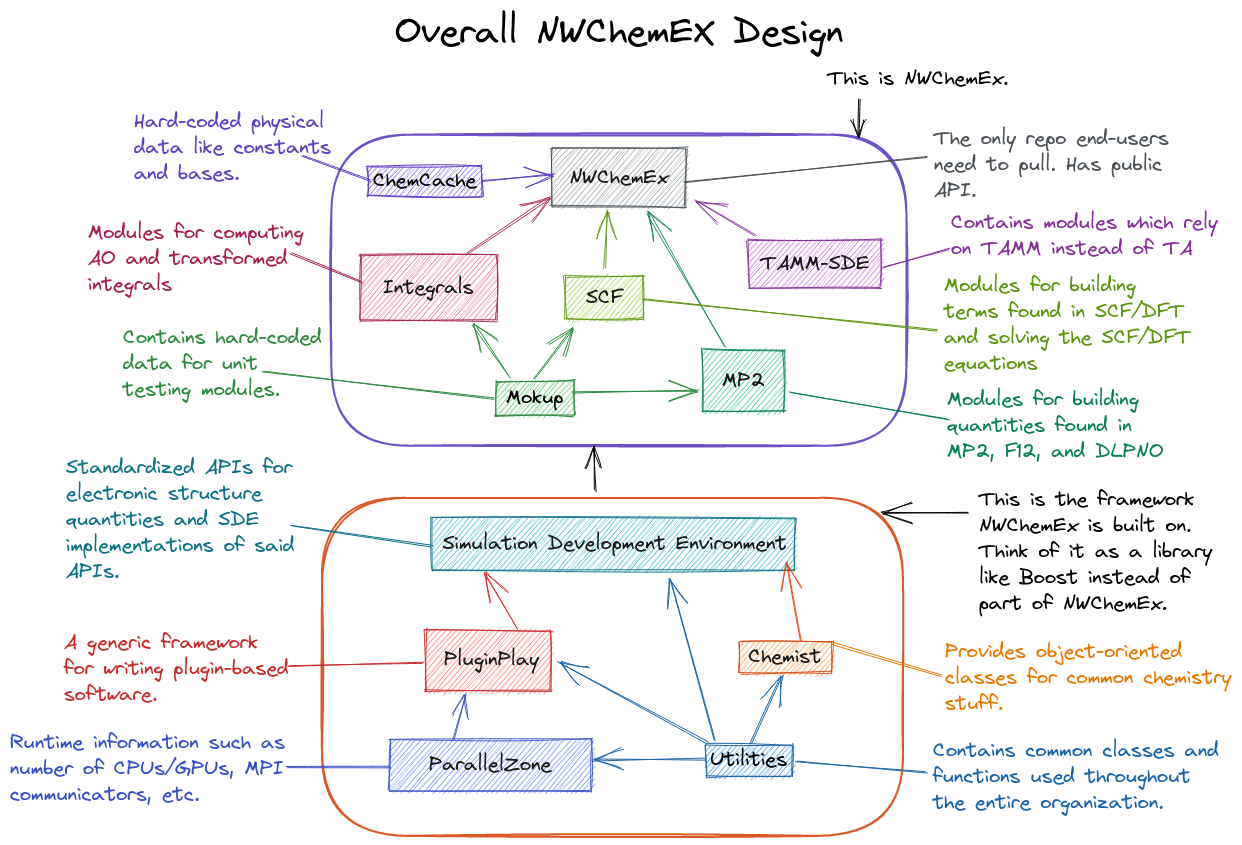Overall Design
The point of this page is to explain the philosophy, organization, and overall design of the NWChemEx software stack.
NWChemEx Organization Overview
The NWChemEx organization manages a lot of repositories. Generally speaking those repositories fall into one of two groups: the framework known as the simulation development environment, or SimDE for short, and the NWChemEx electronic structure package. The breakdown is shown in the following figure:

Fig. 2 Diagram of the overall NWChemEx Design
It’s worth noting that each repo is capable of being used as an independent product (aside from the repos it depends on). Generally speaking, however, we anticipate most people will interact with the stack in one of three ways:
They are writing an external module, in which case they will pull the SimDE repo and use it as a dependency;
They are writing an internal module, in which case they will pull the NWChemEx repo and the module collection they are adding the module to; or
They are running NWChemEx, in which case they will only pull the NWChemEx repo.
These three use cases underlie why we have place an emphasis on the SimDE and NWChemEx repos. The following subsections describe the SimDE and NWChemEx groups of repos in more detail.
SimDE
SimDE encapsulates the infrastructure required to: - interact with the hardware, - manage and run modules, - model and express commonly occurring computational chemistry concepts, and - define the APIs used to compute properties
SimDE is intended to have APIs that are long-term stable. This is important for ensuring modules remain interoperable with the framework for a long time. The goal is to get SimDE to a point where most developers will only interact with SimDE, and will not need to perform development on it. The main exception being the addition of standardized APIs for new properties.
Conceptually you can think of SimDE as being akin to a typical smartphone operating system, but targeting computational chemistry. Like a smartphone OS, SimDE manages a bunch of apps (which we call modules), takes care of inter-app communication (passing data among the modules), and automates more mundane tasks (like logging and saving results). SimDE is extensible in that new modules and communication protocols can be added downstream from it, even at runtime. Specifically the design of SimDE is such that downstream developers don’t need to modify any source code of SimDE to extend it.
This generality and flexibility comes at the cost of complexity. While design efforts have striven to make SimDE as simple as possible, the reality is that it is still quite verbose from a typical electronic structure user’s perspective. It is the responsibility of whatever sits on top of SimDE to provide more user-friendly APIs (in addition to the module functionalities). More complicated workflows can always directly access SimDE for finer-grained control.
The main components of SimDE are summarized in the following table:
Repository |
Description |
|---|---|
Utilities |
General classes/functions, i.e. our own personal Boost |
ParallelZone |
The runtime abstraction layer |
PluginPlay |
Framework for working with plugins |
Chemist |
Chemistry specific classes, used to define APIs |
SimDE |
Definitions of APIs, top-level repo for SimDE |
NWChemEx
The NWChemEx electronic structure theory package is itself made up of two main components: a series of modules for use with SimDE and a user-friendly API for running those modules. If we continue the smartphone analogy, the modules provided by NWChemEx are first-party apps (for Android users think GMail, Google Calendar, Chrome, etc.; iPhone users think Mail, iCal, Safari, etc.). SimDE doesn’t limit you to the modules which come from NWChemEx, and developers are free to write their own modules to use with the NWChemEx package. From the perspective of SimDE, where a module comes from doesn’t matter, i.e., modules that are part of NWChemEx are treated no differently than modules that are not part of NWChemEx.
Finally in the smartphone analogy, the user-friendly API of NWChemEx is similar to the graphical user interface your phone provides. When you click on a street address in an email app and it brings up the location in your map app, you don’t really think about how the apps communicated or what library calls were needed to make that happen. Similarly, when you tell NWChemEx to compute the energy of a molecule, through the user-friendly API, you don’t have to think about how that request gets dispatched through the modules and libraries underlying NWChemEx.
The main components of NWChemEx are summarized in the following table:
Repository |
Description |
|---|---|
Mokup |
Hard-coded tensorial data used for unit testing |
Integrals |
Modules for computing integrals with AOs |
SCF |
Modules related to Hartree-Fock and DFT |
MP2 |
Modules related to Moller-Plesset perturbation theory |
TAMM-SDE |
An assortment of modules which use TAMM instead of TA |
ChemCache |
Hard-coded physical data and basis sets |
NWChemEx |
The top-level repo which provides the user-friendly API |
Miscellaneous Repositories
The NWChemEx organization contains a number of additional “meta” repositories that are not directly required for building NWChemEx. These repos are typically associated with a particular research project, provide CI infrastructure, or in some other way support the project without being source code. The following table summarizes these repositories.
Repository |
Description |
|---|---|
DeveloperTools |
Developer documentation and tools for maintaining NWChemEx |
Publications |
Manuscripts written by the NWChemEx team about NWChemEx |